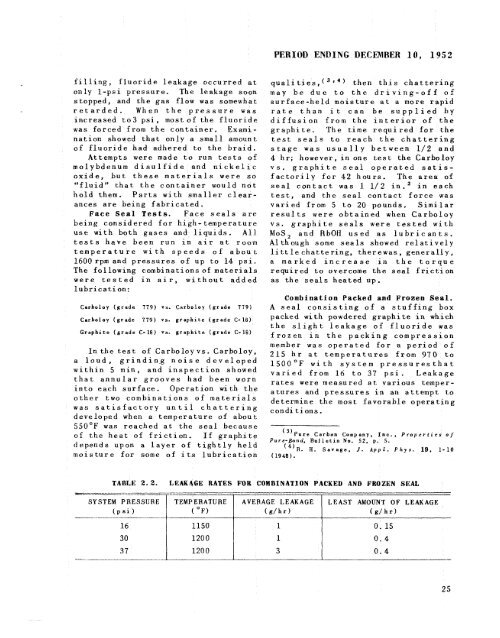the Molten Salt Energy Technologies Web Site
the Molten Salt Energy Technologies Web Site
the Molten Salt Energy Technologies Web Site
Create successful ePaper yourself
Turn your PDF publications into a flip-book with our unique Google optimized e-Paper software.
filling, fluoride leakage occurred at<br />
only 1-psi pressure. The leakage soon<br />
stopped, and <strong>the</strong> gas flow was somewhat<br />
retarded. When <strong>the</strong> pressure was<br />
increased to3 psi, most of <strong>the</strong> fluoride<br />
was forced from <strong>the</strong> container. Exami-<br />
nation showed that only a small amount<br />
of fluoride had adhered to <strong>the</strong> braid.<br />
Attempts were made to run tests of<br />
molybdenum disulfide and nickelic<br />
oxide, but <strong>the</strong>se materials were so<br />
“fluid” that <strong>the</strong> container would not<br />
hold <strong>the</strong>m. Parts with smaller clear-<br />
ances are being fabricated.<br />
Face Seal Tests. Face seals are<br />
being considered for high- temperature<br />
use with both gases and liquids. All<br />
tests have been run in air at room<br />
temperature with speeds of about,<br />
1600 rpm and pressures of up to 14 psi.<br />
The following combinations of materials<br />
were tested in air, without added<br />
1 u b r i cat i on :<br />
Carboloy (grade 779) vs. Carboloy (grade 779)<br />
Carboloy (grade 779) VS. graphite (grade C-18)<br />
Graphite (grade C-18) VS. graphite (grade C-18)<br />
In <strong>the</strong> t.est of Carboloyvs. Carboloy,<br />
a loud, grinding noise developed<br />
within 5 min, and inspection showed<br />
that annular grooves had been worn<br />
into each surface. Operation with <strong>the</strong><br />
o<strong>the</strong>r two combinations of materials<br />
was satisfactory until chattering<br />
developed when a temperature of about<br />
550’F was reached at <strong>the</strong> seal because<br />
of <strong>the</strong> heat of friction. If graphite<br />
depends upon a layer of tightly held<br />
moisture for some of its lubrication<br />
I -<br />
I_._I.-. -<br />
1150<br />
30 1200<br />
37 1200<br />
- __<br />
._ __I I__ -<br />
PERIOD ENDING DECEMBER 10, 1952<br />
qualities,(3 8‘) <strong>the</strong>n this chattering<br />
may be due to <strong>the</strong> driving-off of<br />
surface-held moisture at a more rapid<br />
rate than it can be supplied by<br />
diffusion from <strong>the</strong> interior of <strong>the</strong><br />
graphite. The time required for <strong>the</strong><br />
test seals to reach <strong>the</strong> chattering<br />
stage was usually between 1/2 and<br />
4 hr; however, in one test <strong>the</strong> Carboloy<br />
vs. graphite seal operated satis-<br />
factorily for 42 hours. The area of<br />
seal contact was 1 1/2 in.‘ in each<br />
test, and <strong>the</strong> seal contact force was<br />
varied from 5 to 20 pounds. Similar<br />
results were obtained when Carboloy<br />
VS. graphite seals were tested with<br />
MoSz and RbOH used as lubricants.<br />
A1 though some seals showed relatively<br />
little chattering, <strong>the</strong>rewas, generally,<br />
a marked increase in <strong>the</strong> torque<br />
required to overcome <strong>the</strong> seal friction<br />
as <strong>the</strong> seals heated up.<br />
Combination Packed and Frozen Seal.<br />
A seal consisting of a stuffing box<br />
packed with powdered graphite in which<br />
<strong>the</strong> slight leakage of fluoride was<br />
frozen in <strong>the</strong> packing compression<br />
member was operated for a period of<br />
215 hr at temperatures from 970 t o<br />
1500’F with system pressuresthat<br />
varied from 16 to 37 psi. Leakage<br />
rates were measured at various temper-<br />
atures and pressures in an attempt to<br />
determine <strong>the</strong> most favorable operating<br />
conditions.<br />
(3)P~re Carbon Company, Inc., Properties of<br />
Pure-Bond, Bulletin No. 52. p. 5.<br />
t4)R.<br />
(1948).<br />
H. Savage, J. Appl. Phys. 19. 1-10<br />
AVERAGE LEAKAGE LEAST AMOUNT OF LEAKAGE<br />
(g/hr) (g/hr)<br />
1 0. 15<br />
1 0.4<br />
3 0.4<br />
_I<br />
25



![Review of Molten Salt Reactor Physics Calculations [Disc 2]](https://img.yumpu.com/21979492/1/190x247/review-of-molten-salt-reactor-physics-calculations-disc-2.jpg?quality=85)












